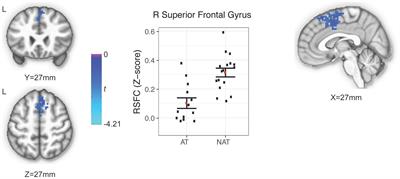Examining putamen resting-state connectivity markers of suicide attempt history in depressed adolescents
Introduction.Suicide is a current leading cause of death in adolescents and young adults.

.
The neurobiological underpinnings of suicide risk in youth, however, remain unclear and a brain-based model is lacking. In adult samples, current models highlight deficient serotonin release as a potential suicide biomarker, and in particular, involvement of serotonergic dysfunction in relation to the putamen and suicidal behavior. Less is known about associations among striatal regions and relative suicidal risk across development.
The current study examined putamen connectivity in depressed adolescents with (AT) and without history of a suicide attempt (NAT), specifically using resting-state functional magnetic resonance imaging (fMRI) to evaluate patterns in resting-state functional connectivity (RSFC). We hypothesized the AT group would exhibit lower striatal RSFC compared to the NAT group, and lower striatal RSFC would associate with greater suicidal ideation severity and/or lethality of attempt. Methods. We examined whole-brain RSFC of six putamen regions in 17 adolescents with depression and NAT (MAge [SD] = 16.4[0.3], 41% male) and 13 with AT (MAge [SD] = 16.2[0.3], 31% male). Results. Only the dorsal rostral striatum showed a statistically significant bilateral between-group difference in RSFC with the superior frontal gyrus and supplementary motor area, with higher RSFC in the group without a suicide attempt compared to those with attempt history (voxel-wise p< .001, cluster-wise p< .01). No significant associations were found between any putamen RSFC patterns and suicidal ideation severity or lethality of attempts among those who had attempted. Discussion.
The results align with recent adult literature and have interesting theoretical and clinical implications. A possible interpretation of the results is a mismatch of the serotonin transport to putamen and to the supplementary motor area and the resulting reduced functional connectivity between the two areas in adolescents with attempt history.
The obtained results can be used to enhance the diathesis-stress model and the Emotional paiN and social Disconnect (END) model of adolescent suicidality by adding the putamen. We also speculate that connectivity between putamen and the supplementary motor area may in the future be used as a valuable biomarker of treatment efficacy and possibly prediction of treatment outcome.
Read the full article at the original website
References:
